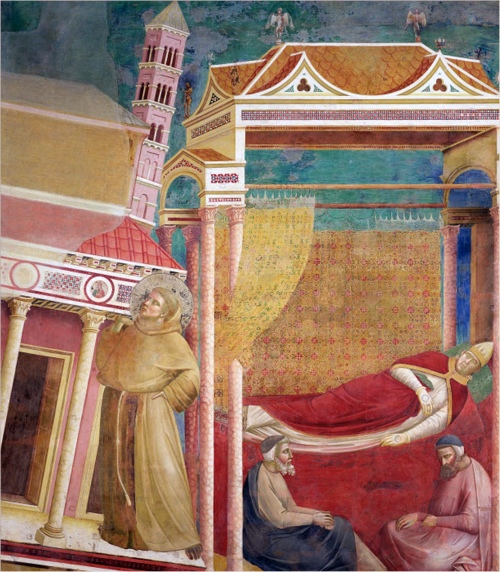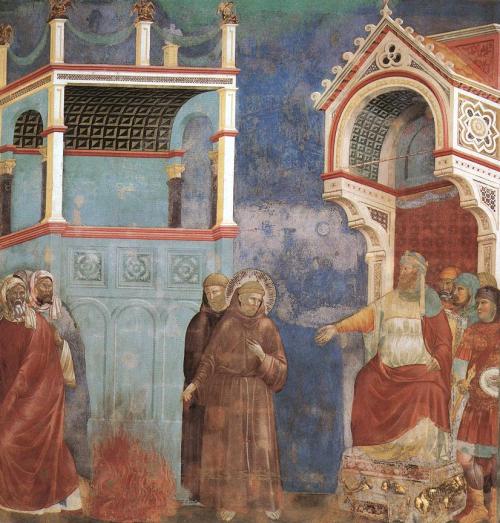In our celebration of the memorial of St. Francis of Assisi we must pause for a moment and examine the virtues that motivated and energized his life.
We can begin by saying that he was a simple man. He pursued simplicity. This does not mean that he was of limited intelligence, or that he pursued simplicity for simplicity sake, rather, it means that he was successful at eliminating everything from his life that did not enhance his understanding and love of Jesus.
In other words, he kept to what was essential in life: “God, the state of our soul, judgment and eternal life.” He realized that “to be simple is to see things with the eyes of God. St. Francis pursued simplicity because he innately knew that God Himself is simple” (from a sermon by Fr. Ronald Knox, 1936).
Other characteristics of Francis’ life are the virtues of faith and love. St. Francis understood that by praying for faith, by acting faithfully and lovingly, his spiritual muscles would be stressed, making him grow stronger in faith and love of God. He knew that God’s grace would assist him in this spiritual exercise if he committed himself to it.
Thus we see his extraordinary reaction to his father’s demand for repayment for the fabrics he took, and sold, to benefit the poor. How did he react when accused? He publicly disrobed; a humble nude standing majestically in the town square. Michelangelo should have attempted to sculpt that scene in marble. For what was the scene?
It was the image of the young Francis, not confronting the Goliath of military invasion, rather, the Goliath of a garden serpent who tempted him to return to the sweet life, la dolce vita. It was the image of the grace of a God given vision to live a virtuous life. Its simple grace would be the stone that would bring down the giant of his own ego and worldliness.
The magnificent Florentine painter, Giotto (1226-1337), born the same year St. Francis died, painted these virtues of St. Francis at work when he portrayed Pope Innocent III’s dream of Francis holding up the pillars of the Church.
It was St. Francis, and his fellow friars that would live in their daily lives the virtues of poverty, chastity, and obedience. These virtues, within the Franciscan perspective, would sweep the imagination of Europe and even gain respect in the Mid East.
How does this apply to an artist? Sacred artists must strive for balance in their spiritual and artistic life. Giotto is a wonderful example for us because he combines the principles of action and contemplation. Like Francis, Giotto was balanced. He achieved simplicity in his portrayal of spiritual truths, and was able to witness continual dedication to combining action (art) with contemplation (prayer during the creative process).
Giotto was a master of painting sacred images that made St. Francis’ life come alive. For example, he captures the spirit of Francis in the Holy Land and brings a favorite story about him to life. In the year 1219 during the Fifth Crusade, Francis traveled to the Holy Land, where he was captured and beaten by the Muslims.
St. Bonaventure tells us in his history of the Franciscan Order that St. Francis was brought before the sultan Al Kamil, and he preached to him about love and the meaning of Jesus’ life. When Francis finished his sermon he then challenged the Sultan’s imams to a religious test to determine which was the true religion – Islam or Catholicism. The painting below, entitled Trial by Fire by Giotto, illustrates the drama of that moment.
“Francis said to the Sultan: “Please have a bonfire lit, and have your imam, along with me, enter the fire – so let it be that his God is the true God whoever emerges from the flames unhurt.”
The Sultan’s eyes lit up – now this is a man of faith!
His imams, however, felt that they had better things to do.
But from that moment on Al Kamil was so impressed with Francis that he gave the Franciscans safe passage to travel and stay unhindered, anywhere, in Muslim occupied territories; and as a direct result of this act, eight hundred years later, if you go to Jerusalem you will see that the Franciscans are still the Catholic Religious Order responsible for the maintenance of the holy shrines.
Theologian Dr. Marcellino D’Ambrosio teaches us that “St. Thomas Aquinas explains that a virtue, like a physical muscle, is a habit – a power or capacity – that gets stronger when its exercised – and atrophies – when it is not.” St. Francis shows us that faith and love, prayer and service are the main muscles in our spiritual body; and for artists they are the virtues that keep our lives balanced. Are we not all artists?
The life of St. Francis of Assisi was, itself, a work of art. For it was one in which the person, Francis, cooperated with the grace of God and allowed himself to be sculpted by the Divine Artist Himself; may we all be as courageous to do the same.
*Readers are welcome to read my post of March 4, 2021 entitled St. Francis of Assisi: A Nice Man or a Soldier of Christ – https://fraangelicoinstitute.com/2021/03/04/st-francis-of-assisi-a-nice-man-or-a-soldier-of-christ/
Copyright © 2011- 2021, Deacon Paul O. Iacono – All Rights Reserved. Permission to reprint must be obtained from the author through making comment on this post in its comment section. Students, and those interested, may quote small sections of the article as long as the proper credit and notation is given. Thank you.




Hey, Deacon Paul–this might be my favorite so far of all of your posts. The artwork is just beautiful. I like the bits of history intertwined, and I like the relating of this to art. Action and contemplation, yes, you are right. Thank you for this fresh look at a saint that I have heard so much about, I might have been tuning out: this is my favorite part: “. . . young Francis, not confronting the Goliath of military invasion, rather, the Goliath of a garden serpent who tempted him to return to the sweet life . . . ” When I read that, the image in my head was not of a disrobing young man defiantly standing in a courtyard–but that of a young Chinese man standing in front of a tank in Tieneman Square in Beijing, hand raised in protest. I suddenly realized, through the juxtaposition of those images inspired by your words, what incredible courage it took to defy the might of convention, of family, of wealth, of culture, and walk alone to join the Lord in simplicity and service. It gave me a whole new view of St. Francis, and how radical and holy he truly was. Not a sentimental cuddler of bunnies and tamer of wolves, but a truly faithfilled and courageous reformer.
LikeLike
Thanks, and yes you are correct. His courage in the face of secular society, and the “wisdom” of the world is inspiring and an excellent example of God’s grace working in his life – and ours , too, if we accept His gifts.
LikeLike
this information helps me a lot in my assignment in christian living formation
LikeLike
Geraldine,
I am pleased that it helped you complete the assignment.
Best wishes,
Deacon Paul Iacono
LikeLike